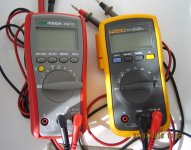Yup, it's the Isotech. I've been using the Fluke for a while now but it wasn't very happy measuring resistances below 10ohms. So I went looking and picked up the Isotech (in box, no manual) and with a cracked glass.
The manual was no problem to get and afterwards, I bought the software and cable from RS.
The glass took a little longer to fix but I milled a replacement for it a few days later and epoxied it in without problems. Cost for the meter - the equivalent of US$5-. from Cash Converters.
How did this happen? Tell the seller moisture ingress through the cracked glass will kill the meter in a matter of weeks😀
bulgin
The manual was no problem to get and afterwards, I bought the software and cable from RS.
The glass took a little longer to fix but I milled a replacement for it a few days later and epoxied it in without problems. Cost for the meter - the equivalent of US$5-. from Cash Converters.
How did this happen? Tell the seller moisture ingress through the cracked glass will kill the meter in a matter of weeks😀
bulgin
Attachments
Any idea why Fluke has printed Hz next to the two DC reading scales?
Hmmm... well the manual implies you can measure DC current and DC voltage "frequency". It also implies frequencies over 500hz are a "shock hazard"... well that's how it reads to me.
Guess you would have to play with one to see what it does.
Page 13,
http://www.fluke.com/download/manuals/11x_____umeng0100.pdf
took me a little while to realise that p13 of the PDF = p9 of the manual.
That sounds like rubbish to me.
Press the Hz button to count the number of times the 0V,0A trigger threshold is crossed while measuring a DC voltage or a DC current.
Implied or gobbledegook?
As you say the only way would be to buy one.
Well not me, the best accuracy quoted for these models is +-0.9%, +-2LSB.
That's crap.
That sounds like rubbish to me.
Press the Hz button to count the number of times the 0V,0A trigger threshold is crossed while measuring a DC voltage or a DC current.
Implied or gobbledegook?
As you say the only way would be to buy one.
Well not me, the best accuracy quoted for these models is +-0.9%, +-2LSB.
That's crap.
Depends on the signal you are looking at. To measure frequency of your AC mains, you obviously use the AC volts position and turn on frequency. However, when you are using a Fluke to look at TTL logic circuits that transition between 0 and 5 volts, you actually get a better reading by putting the meter on DC volts and turning on frequency. This moves the trigger position from 0 to about +2V. Having a trigger at 0V works great on house mains, but not very well with digital logic. Similar situation with automotive signals (timing), which transition between 0 and 14V. The meter is smart.
For $5 I'm happy you got a good working meter. Personally, I avoid multimeters under $200, so we are in apples-oranges territory. I have multiple Fluke 87's, and will have to go through a spiritual conversion before going to another manufacturer. Tried all the others, and there was truly no comparison. I have found that when my Fluke fails to give me the answer, no other meter will - time to break out the oscilloscope. But then again, I haven't compared the sub-$100 meters.
For $5 I'm happy you got a good working meter. Personally, I avoid multimeters under $200, so we are in apples-oranges territory. I have multiple Fluke 87's, and will have to go through a spiritual conversion before going to another manufacturer. Tried all the others, and there was truly no comparison. I have found that when my Fluke fails to give me the answer, no other meter will - time to break out the oscilloscope. But then again, I haven't compared the sub-$100 meters.
- Status
- Not open for further replies.
